Sprouting beans at home is an affordable way to pack in delicious plant-based protein and nutrients, while also making the legumes more digestible (and delicious). Here’s our quick start guide to sprouting virtually any legume!
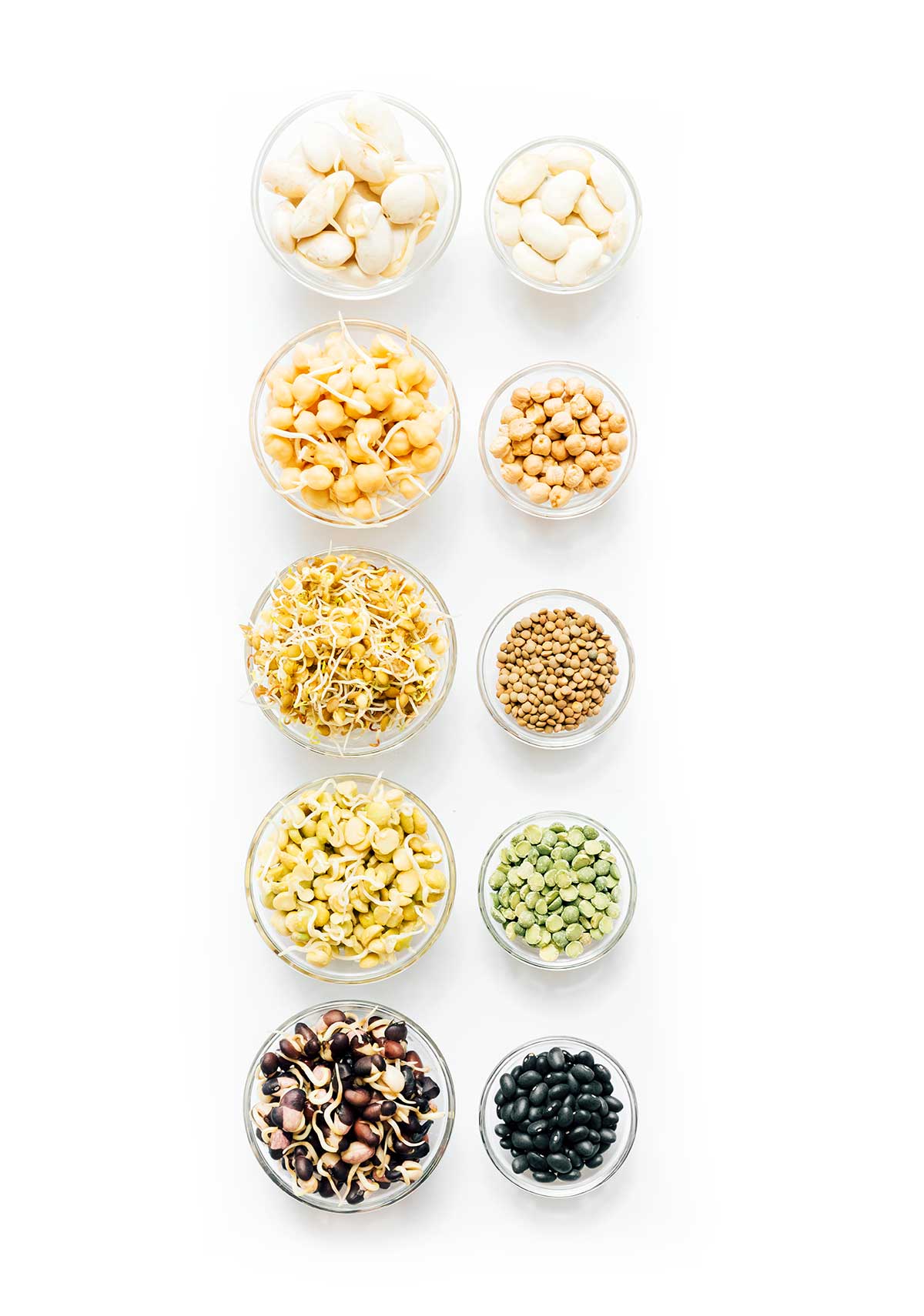
Who else here was obsessed with sprouts growing up? Not like the edible kind, but the kind you made as a science fair project. There was something so magical about putting seeds in a damp paper towel, giving them sunlight, and watching them grow.
These sprouted beans and legumes are the supercharged, grown up version of that science fair project. They’re easy to grow, don’t require any special gear, and transform the humble bean into a nutrition powerhouse. Let’s sprout!
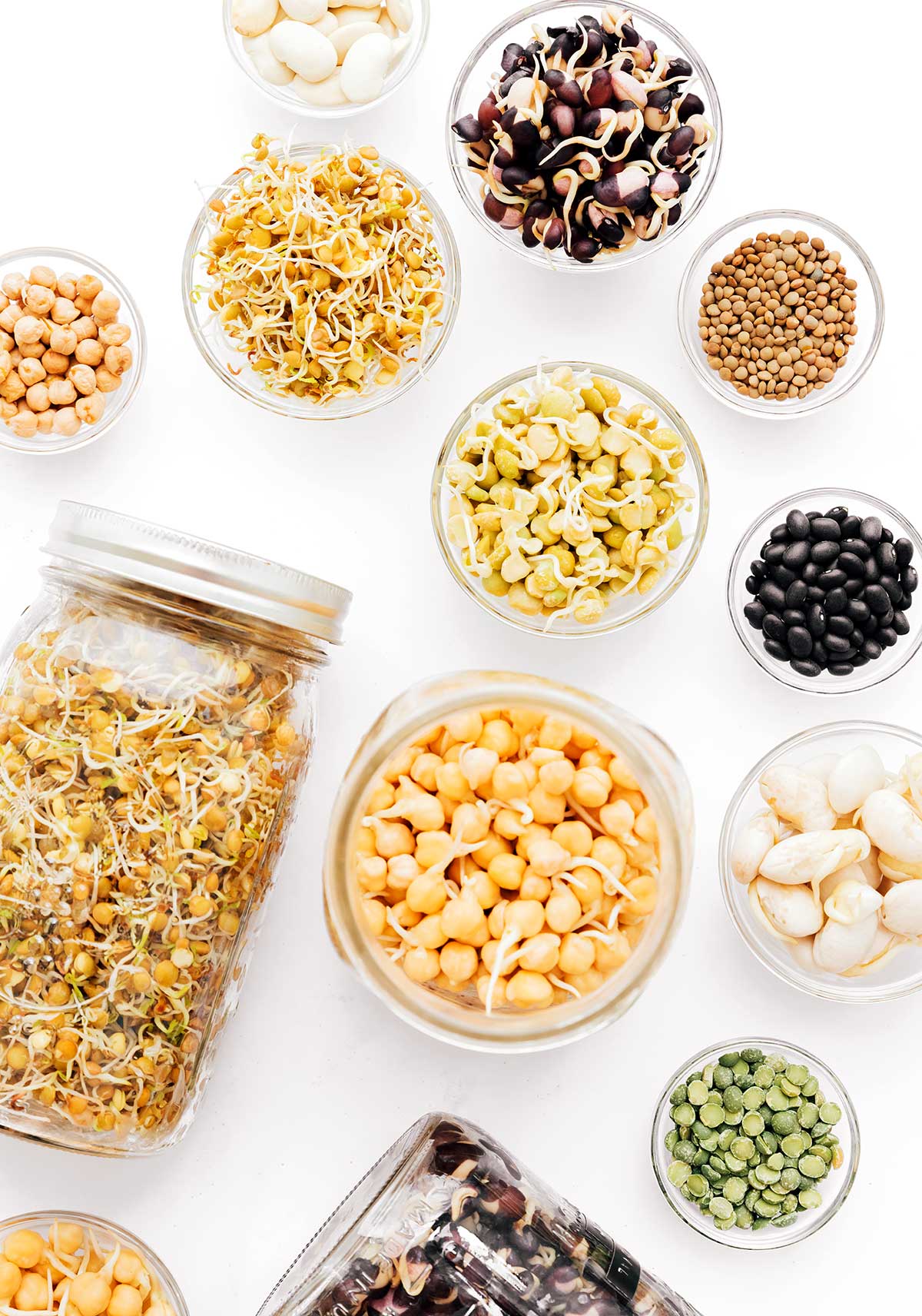
Benefits of sprouting
Nutrition: The process of sprouting transforms a lot of the starch in legumes into a more nutrient-rich food, increasing the amount of folate, iron, vitamin C, zinc, magnesium, and protein. It also breaks down phytate, which is a compound that prevents nutrient absorption.
Digestible: During this transformation, the starchy endosperm is also broken down, meaning sprouted beans may be easier to digest for some people.
Affordable: While you can buy sprouts at your grocery store or farmer’s market, they’re often expensive and can be made for a fraction of the cost at home!
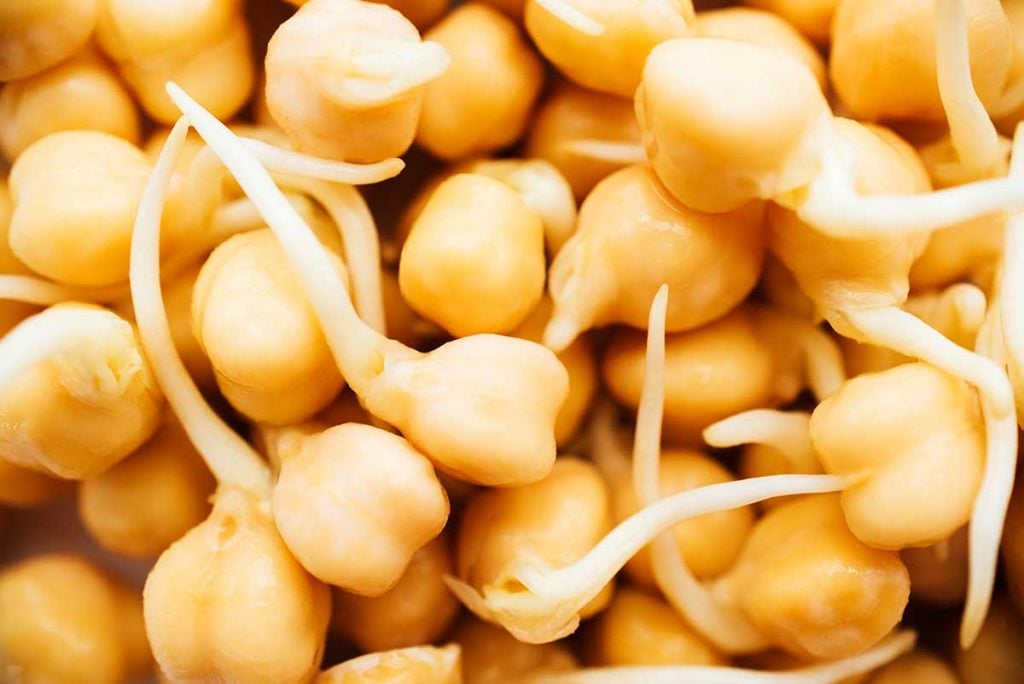
What can you sprout?
You can sprout many things, such as legumes, seeds, nuts, and grains. Today we’re focusing on one of the most common ingredients to sprout – legumes! This includes chickpeas, lentils, green peas, black beans…really any type of bean!
As a note, we are not sprouting any kind of kidney beans, which can contain potentially toxic compounds that require you to cook them before consuming.
Do you need special beans?
When it comes to sprouting beans at home, you have two options: sprouting seeds or regular.
Sprouting seeds are specifically meant for sprouting, so they have been treated and cleaned in a way that makes them more suitable for sprouting. These are most likely to actually sprout, and are less likely to carry nasty pathogens – like e. coli and salmonella – which like the warm humidity of your sprouting environment.
Regular “seeds” are basically just store bought dried legumes! This could be dried beans, chickpeas, lentils, etc. Because the manufacturers expect that you will cook the beans before consuming, these may not be cleaned sufficiently for sprouting.
So which did we use? Regular seeds! If you’re going to sprout more longterm, we would recommend investing in good sprouting seeds. But as a fun occasional project, basic grocery store dried legumes worked well for sprouting.
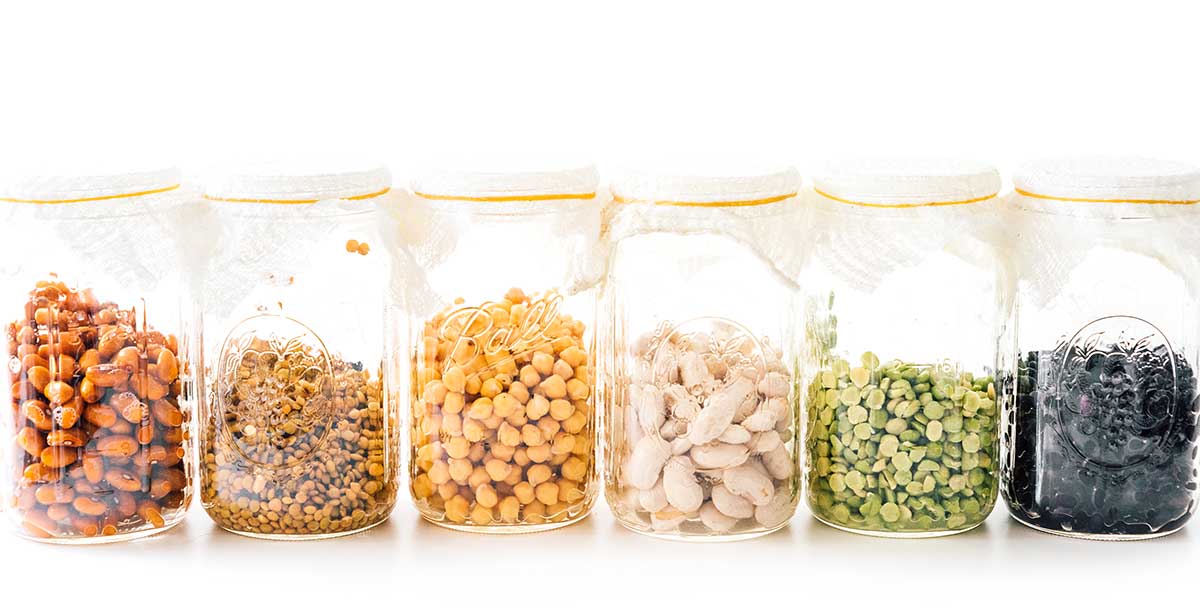
What equipment to you need for sprouting?
Sprouting doesn’t require any special equipment. You’ll just need a breathable container! A wide-mouth mason jar topped with a cheesecloth does the job perfectly.
If you find that you love sprouting and want to do it more often, we recommend a sprouting lid that screws right onto the top of your mason jar.
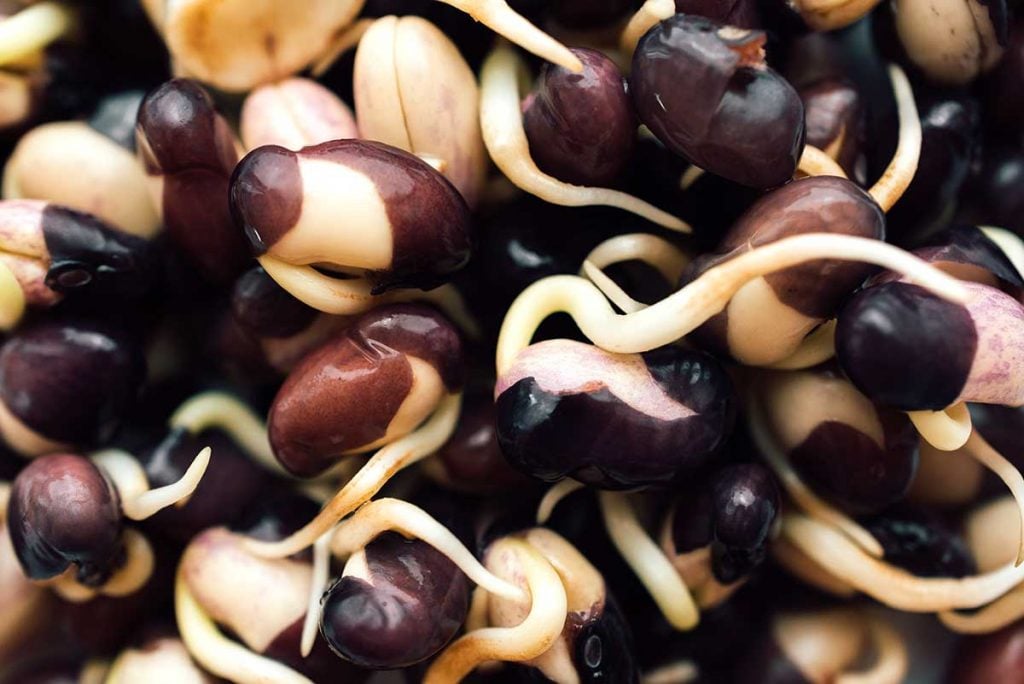
How to sprout beans and legumes
Sprouting is a simple process that goes something like this:
- Soak legumes to soften
- Rinse well with cool water
- Drain water from jar
- Repeat steps 2 and 3 until sprouts form
- Store in the fridge until ready to eat
It really is that simple! Let’s get into the nitty gritty of it.
Step 1: Soak
Add your chosen dried legume to large bowl or jar and cover with cool water. The water should be a few inches above the dried legumes – they’re going to expand! Soak for 8 to 12 hours (or overnight).
Step 2: Rinse
Rinse the legumes well, then place them in your sprouting vessel (a widemouth mason jar works well).
Step 3: Drain
Pour out the water. Secure a clean cheesecloth (or sprouting lid) over the jar using rubber bands. Prop the jar upside down at an angle to allow excess water to drip out. For many jars at once, a drying rack or cooling rack work well.
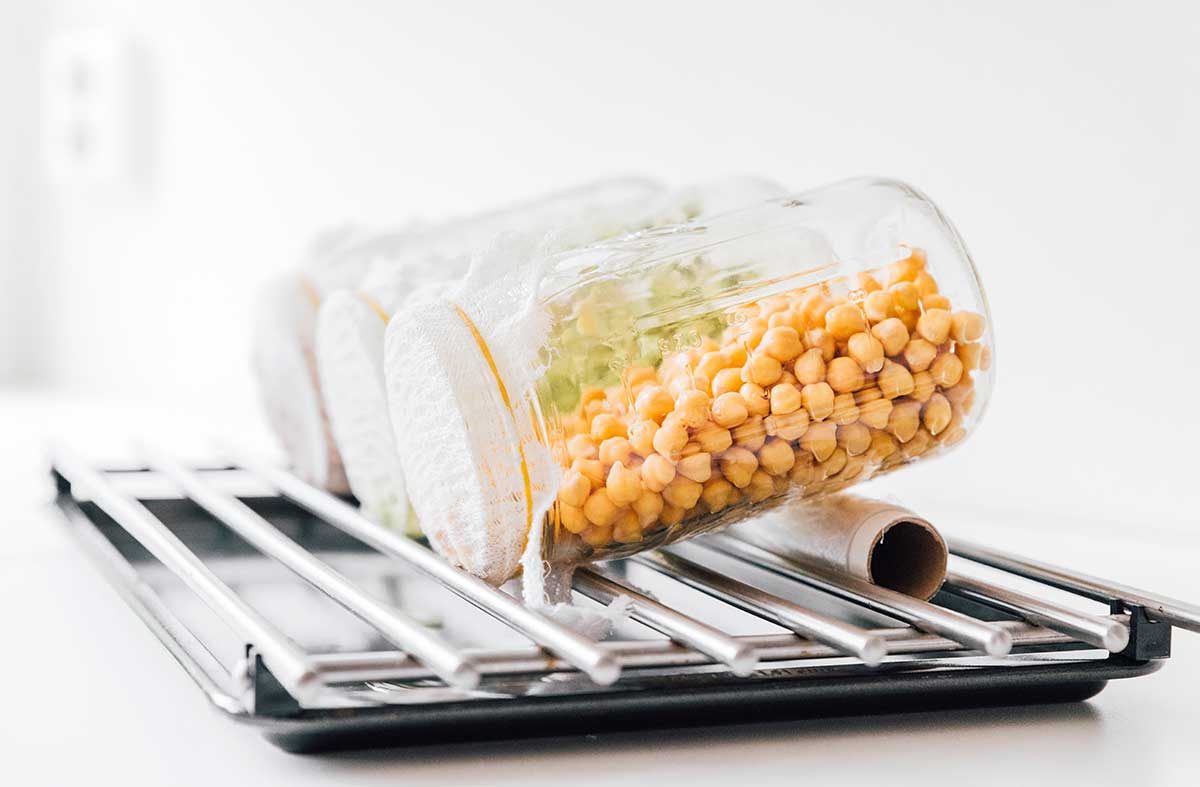
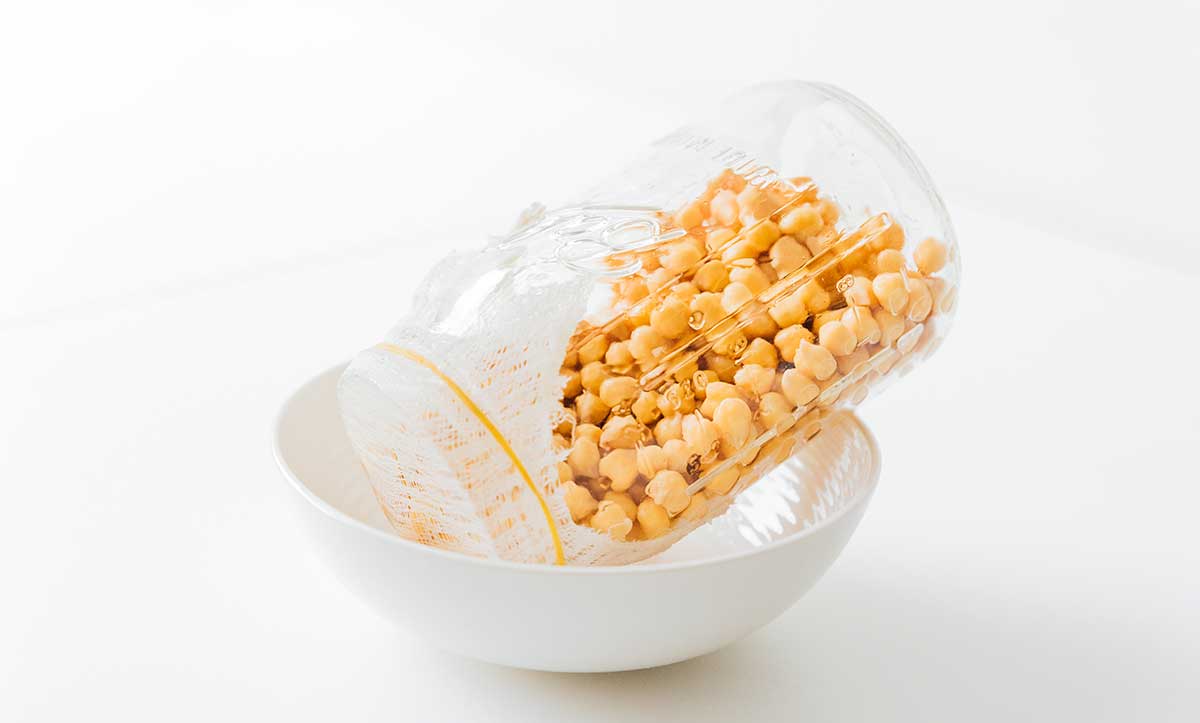
Step 4: Repeat
Rinse and drain the sprouting legumes 2 to 3 times per day (morning, noon, and night works well). Continue this for 2 to 3 days, or until sprouts have reached 1 to 1½ inches long.
On the last day, you can expose them to sunlight if you want them to develop a bit of green (chlorophyll).
Step 5: Store
Wrap sprouts in a clean cloth or paper towel and set in a clean, airtight container. These won’t keep long, just 2 to 3 days in the fridge, so eat them while they’re fresh!
Sprouted Chickpeas
Sprouted chickpeas (or garbanzo beans) are a reliable legume to sprout that are easy to find in most stores! They have a creamy, nutty texture that works well on salads and in soups.

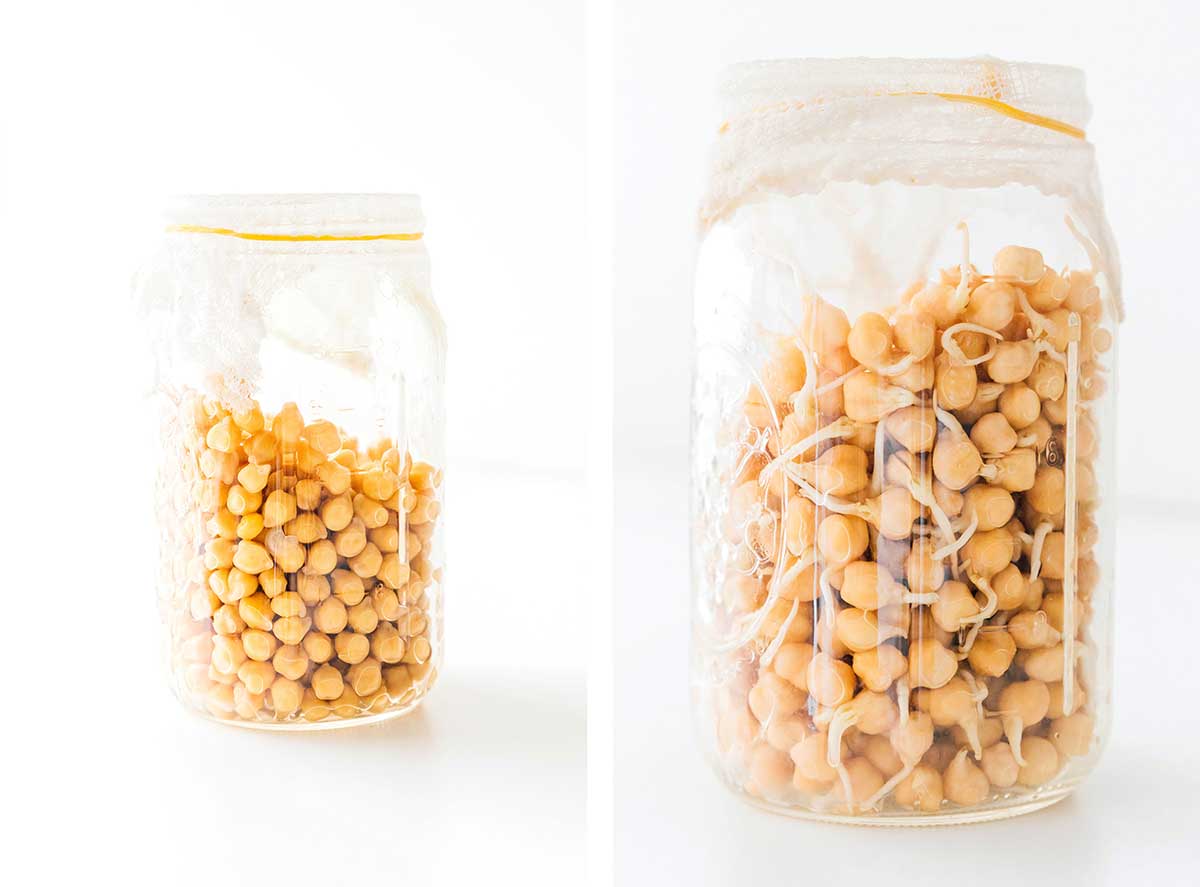
Sprouted Lentils
Lentils grow long sprouts and are almost foolproof, so they’re great for beginners! These are delicious on sandwiches and in wraps, or cooked into a stir fry.
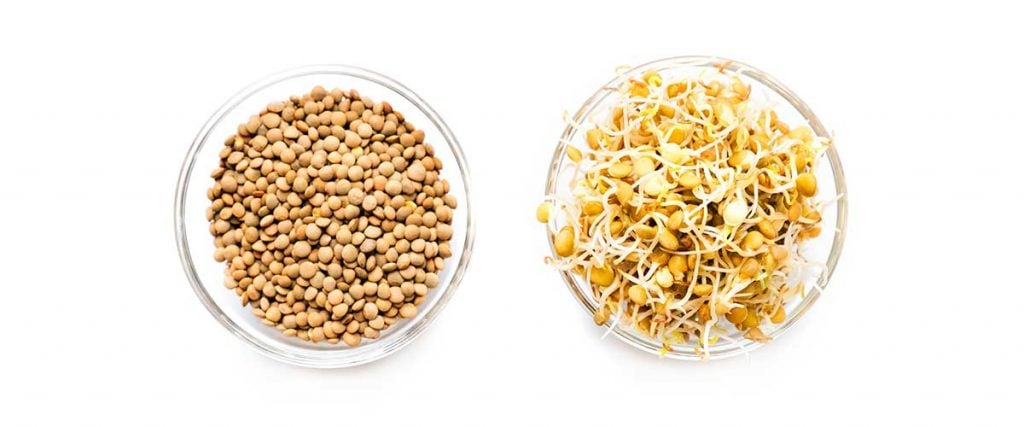
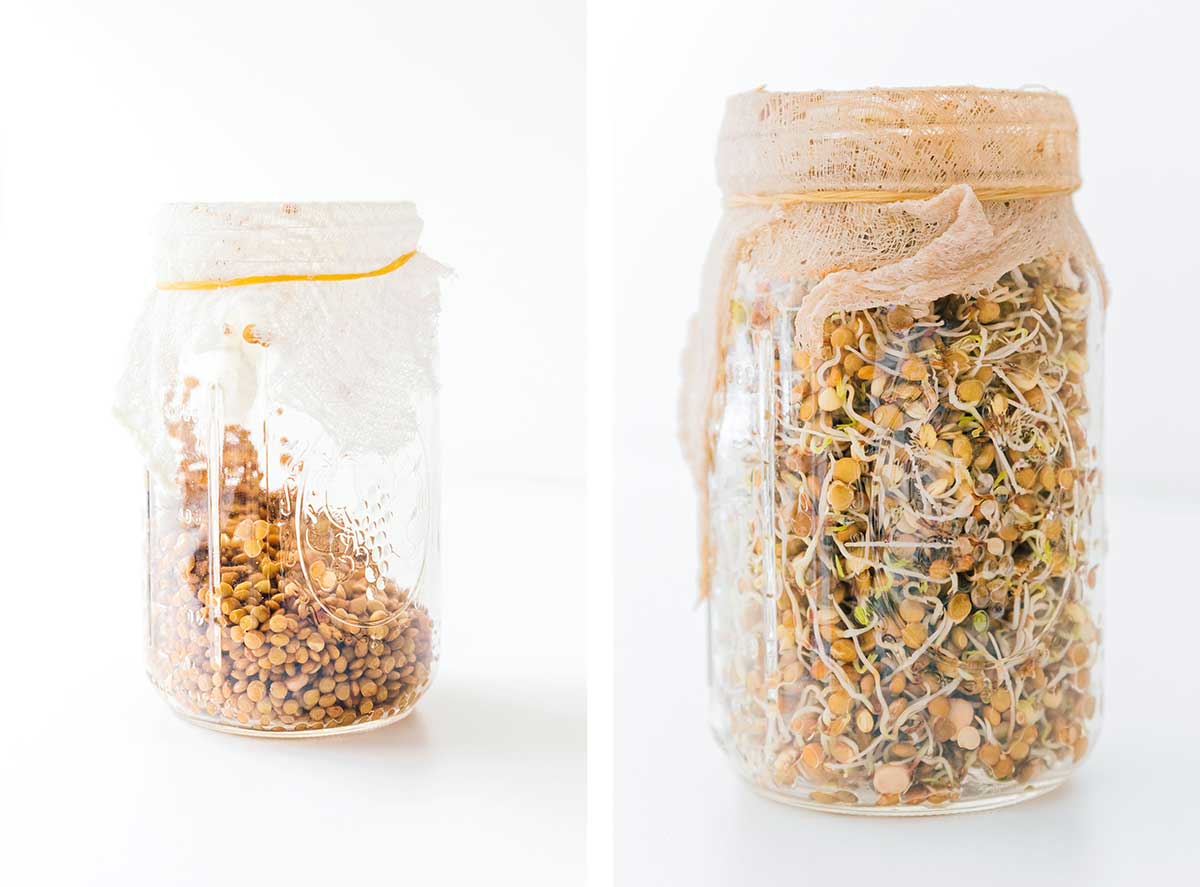
Sprouted Navy Beans
Bigger beans can be difficult to sprout and may have a longer germination time, but that doesn’t make them any less delicious! These sprouted navy beans (a.k.a. haricot, Boston, or white pea beans) have a firmer texture and are delicious sprinkled over salads.
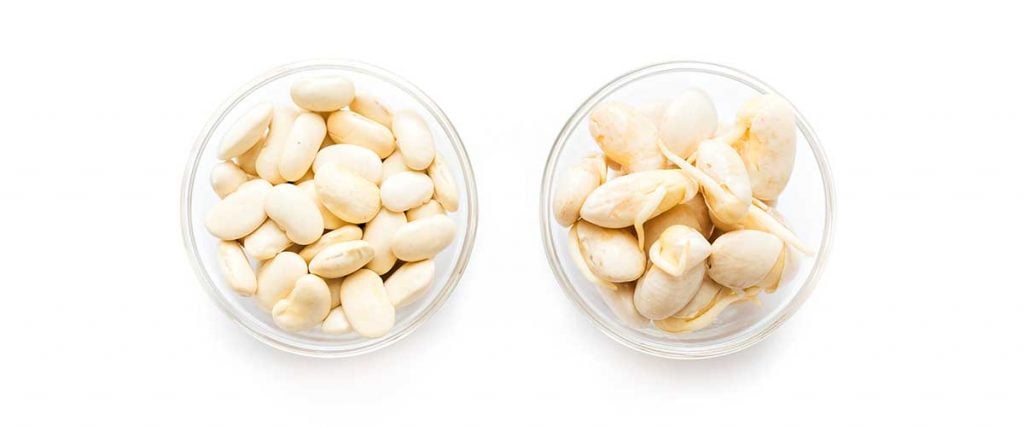
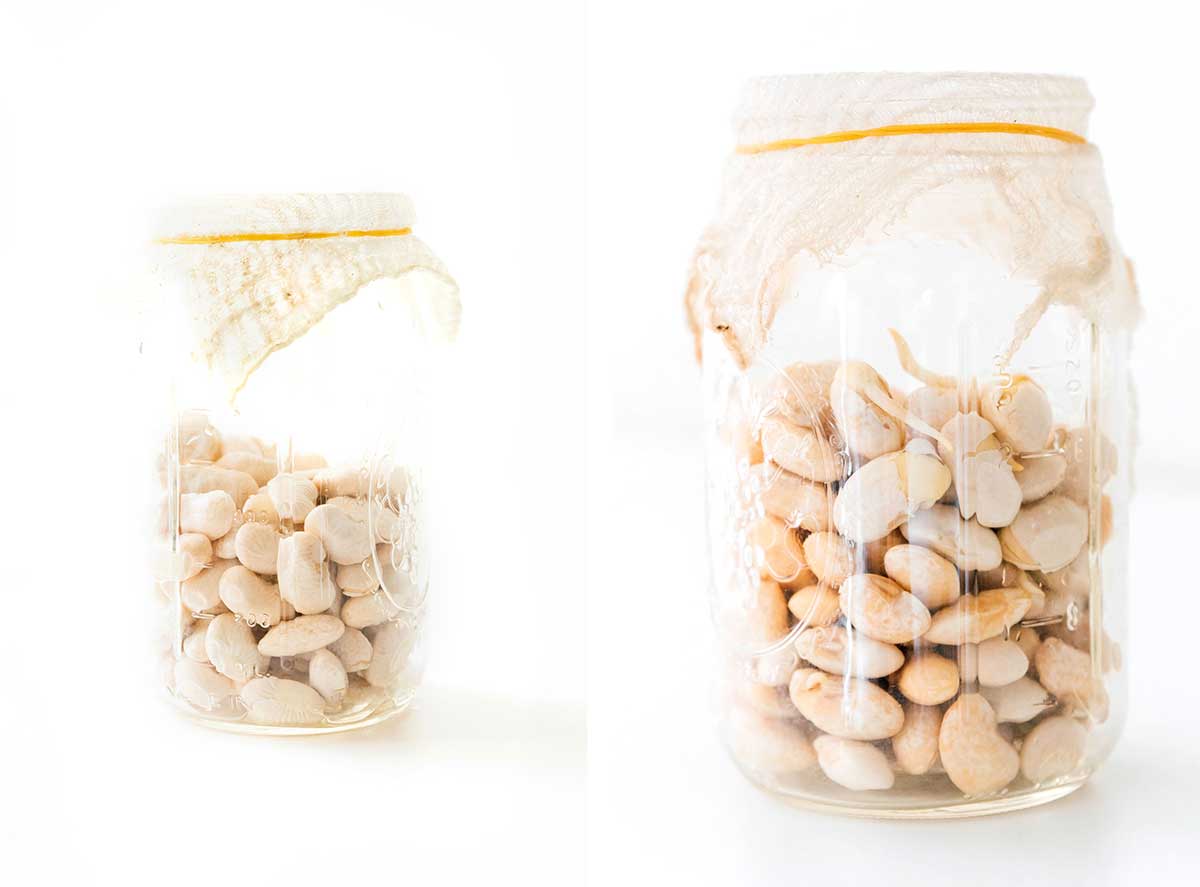
Sprouted Black Beans
While sometimes finicky when it comes to sprouting, black beans can work well! Use sprouted black beans almost anywhere that you would use regular black beans, like in tacos, burritos, or southwest salads.
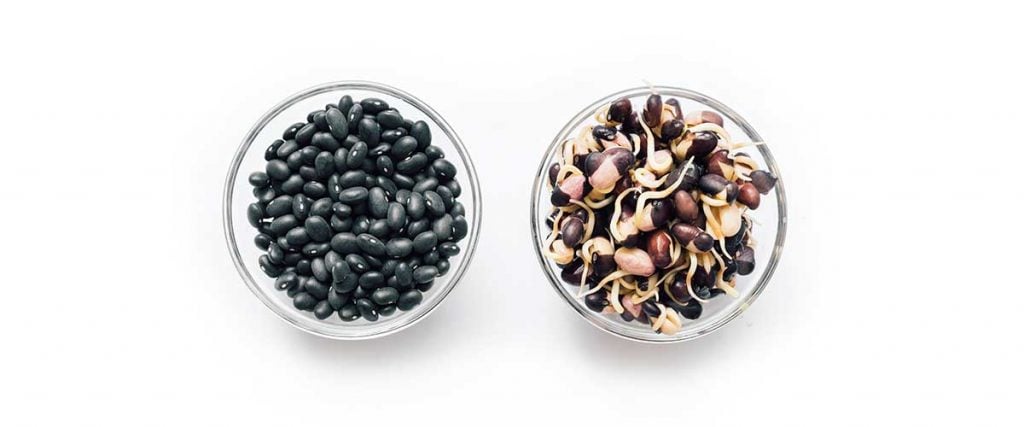
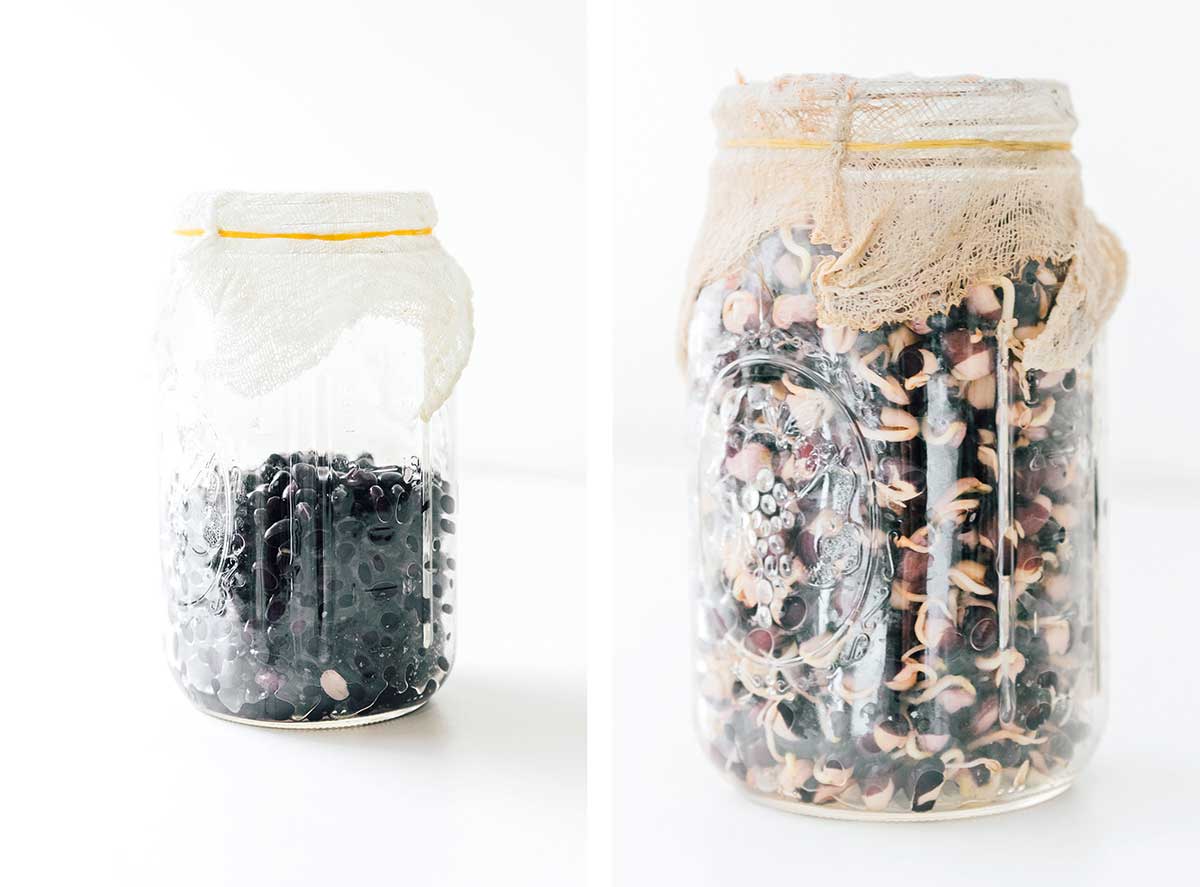
Sprouting FAQs
When grown in a sterile environment, sprouts are safe to eat. Given that they’re grown in a humid environment, they are a risk for food borne pathogens, like salmonella and e. coli. If you’re worried about these (like if you fall into a risk group), saute the sprouts before consuming.
Mold is usually due to high humidity and poor air flow, so be sure to rinse your sprouts regularly and drain them well. You should also ensure all equipment is sterile.
Sprouts can be consumed raw or cooked! To cook, saute them with a splash of oil, or simply stir them into hot soups and stews.
Canned legumes have already been cooked, so they are not suitable for sprouting.
Some uncooked beans, such as kidney, lima, and broad beans, need to be cooked before consuming to remove toxins. We recommend simply not sprouting these beans.
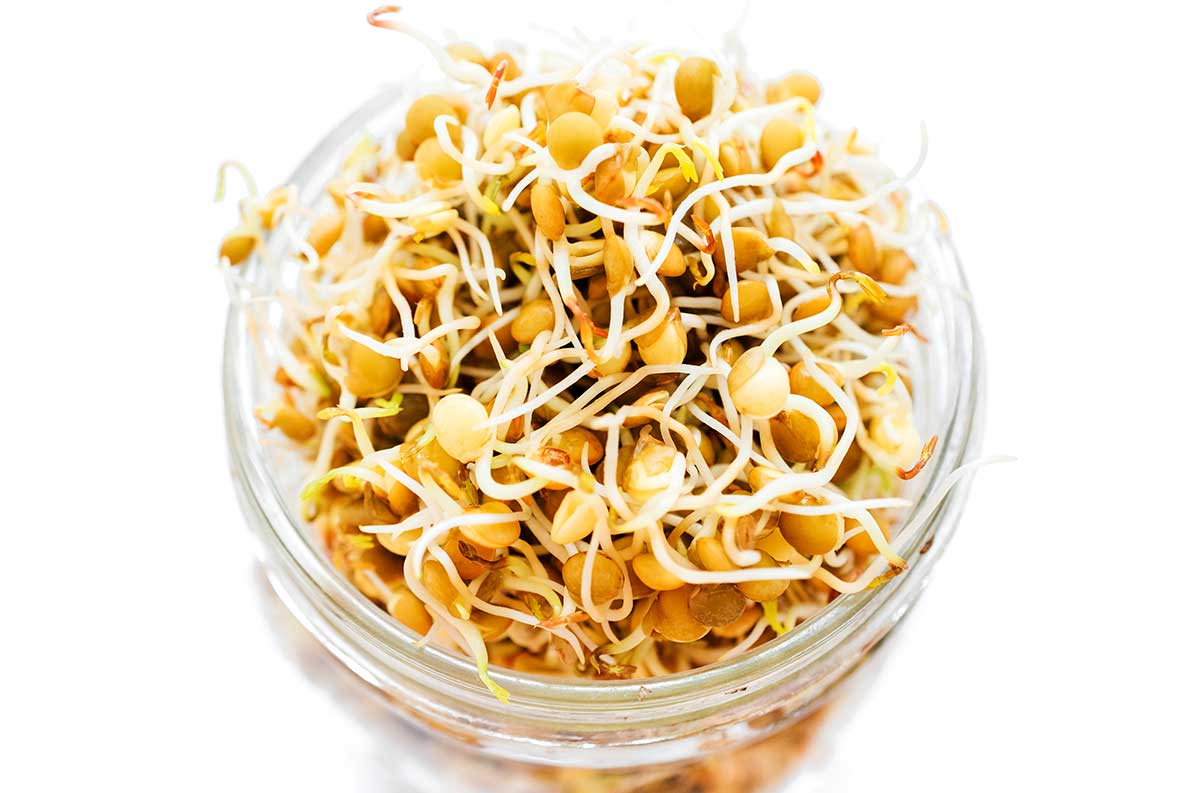
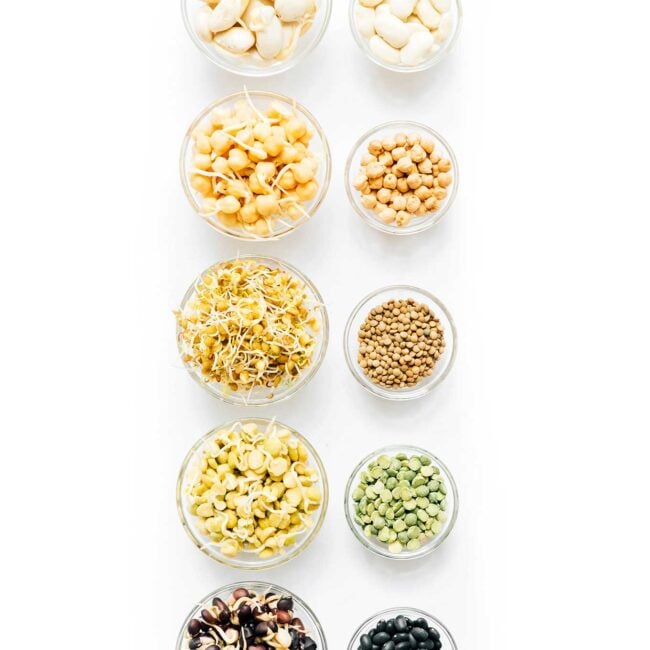
Ingredients
- Dried legumes like chickpeas lentils, black beans, navy beans, or green peas
Instructions
- Soak: Add your chosen dried legume to large bowl or jar and cover with cool water. The water should be a few inches above the legumes – they’re going to expand! Soak for 8 to 12 hours (or overnight).
- Rinse: Rinse well, then place legumes in your sprouting vessel (a widemouth mason jar works well).
- Drain: Secure a clean cheesecloth (or sprouting lid) over the jar using rubber bands. Prop the jar upside down at an angle to allow water to drip out. A bowl, drying rack, or cooling rack work well.
- Repeat: Rinse and drain the sprouting legumes 2 to 3 times per day (morning, noon, and night works well). Continue this for 2 to 3 days, or until sprouts have reached 1 to 1½ inches long. On the last day, you can expose them to sunlight if you want them to develop a bit of green (chlorophyll).
- Store: Wrap sprouts in a clean cloth or paper towel and set in a clean, airtight container. These won’t keep long, just 2 to 3 days in the fridge, so eat them while they’re fresh!
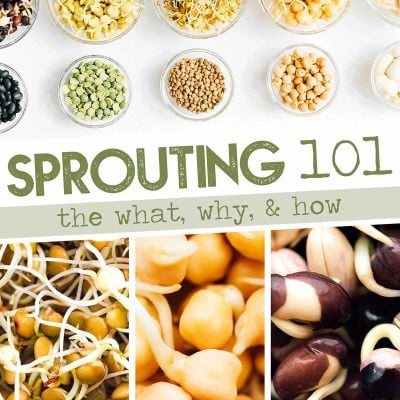
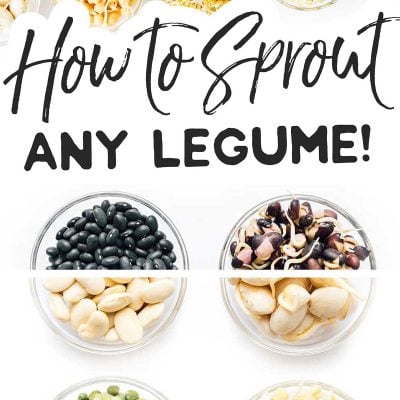
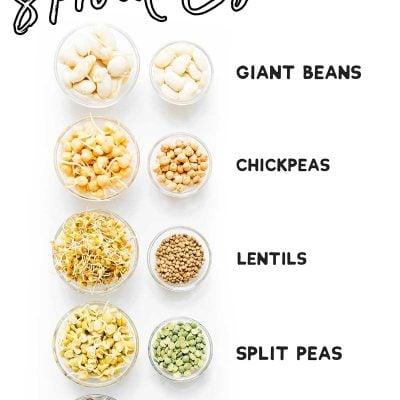
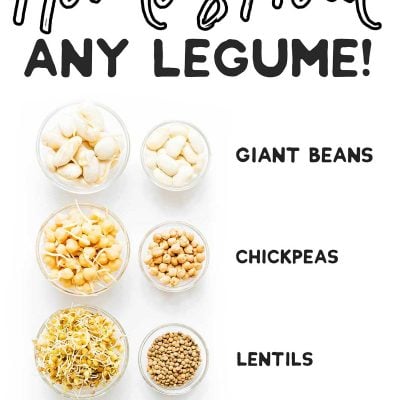
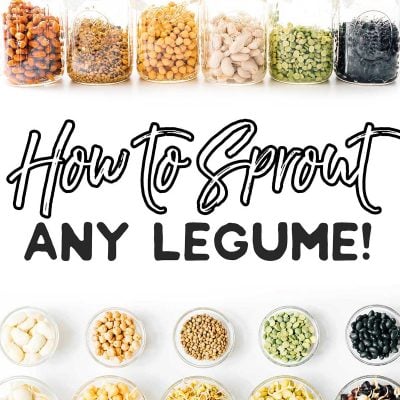

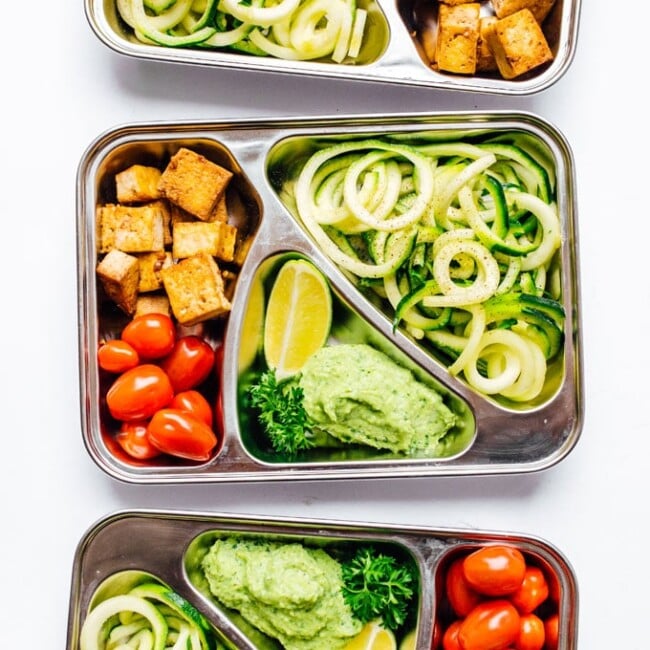


Jean Mukti Kuster says
Thank you Sarah! I have been having lots of problems trying to sprout beans. I will get some sprouting seeds, and sterilize my containers. That makes a lot of sense. I really appreciate your very comprehensive treatment of these types of sprouts. It helped me a lot.
Sarah says
So happy to hear it, Jean! Let me know if I can clarify anything! 😀
kanta masters says
You did a terrific job here! Clear, concise, and absolutely informative!
Thank you so much for all you do for ALL of us!
MICHELLE Y DESCHENES says
Thank you so much for sharing this article, and all the details! Super helpful!
Sarah says
So happy to hear it, Michelle! 😀
Randolph says
Can you use sprouted beans in chili as I get gas from all beans as well as broccoli cabbage eggs flour tortillas really bad and no one wants to be around me. Lol but I want to get rid of passing gas I guess some people have this problem. Anyway this is why I want to know how to sprout them before cooking them.
Sarah says
Yep you could use these in chili! 😀
Morgan Luka says
Can you freeze them? If yes, what would you recommend freezing them in?
Thank you!
Sarah says
You can, but they will lose some of their crunchy texture when thawed again. I would freeze in an airtight container or baggie in aa single layer. Enjoy! 😀
Jenn says
Where do you buy sprouting bean seeds?
Sarah says
You can find them online here, or in some health food stores!
Sonia Nahum says
Thank you very much for this summary.
Krystal says
Hi. I tried sprouting Garbonzo beans. Kidney and black beans. The garbanzo beans grew white fuzz on them and I threw them out. The kidney and black beans have an odor to them. (I was sprouting them to make chili) I don’t know why the smell. Should I throw them out and try again? Or are they ok if they get cooked?
Sarah says
If there’s an off smell then I probably wouldn’t consumer them. Sounds like they all just need a little extra rinsing and better drainage to prevent mold!
FCD says
I sprout beans before planting them. Most beans will germinate well for about 2-3 years, then many of them instead of germinating will start decomposing. That is the nasty smell. I’m also finding a slimy stretchy something on some of the decomposing ones. I assume it is some kind of bacterial (maybe?) slime from a decomposing organism. Anyone know what that slime really is and what organism creates it?
But the diminishing germination rate in beans is the best reason to buy beans sold specifically for sprouting. I wouldn’t eat organic fresh purchased seeds intended for planting. Planting seeds are processed differently from eating seeds. They may be treated with chemicals or processed in a facility that treats other seeds with something. Good reasons to purchase organic too.
Sitah says
Thank you very much, your steps easy to follow. You make things simpler for me
Alicia Glassel says
Hello. When you say to store them “away from sunlight” do you mean in a dark place? Or do you just mean away from DIRECT sunlight? Bottom line, is indirect sunlight, like on my kitchen counter, OK?
Sarah Bond says
The darker the the better! But the kitchen counter should be fine, I’ve done it before and simply covered it with a tea towel 😀
Tahira says
Very well explained.
Anna says
Thank you for simplifying how to sprout and use legumes, seeds, grains and nuts!
Anna
Cindy says
Thank you! I have a 6 layer kit and could not find my instructions so I thank you for this valuable information! I plan to use it much more than in the past! Thank you very much!!❤️
Karen says
THANK YOU FOR THE REFRESHER COURSE 🙂
I have not sprouted in years & now that we are in a higher price rate across all things we buy…. let’s start sprouting again!
I found using a flour sack very simple.
I soak 8 -12 hrs as you stated then I hang them in a flour sack to drip and plenty of airflow because it is not in a solid container.
Irinse right in the flour sack bundle in a poy of freshwater dunking a few times after I open the sack checking for mold fuzz etc, then hang back up.
this not only serves great airflow but since they are bunched together they sprout faster under pressure.
Adam says
Thank you for the information! (:
It is very helpful.
Tty says
I am curious what kind of “toxins ” might be in kidney beans that can be cooked out?
Sarah Bond says
They’re called phytohemagglutinin (or lectins)! 😀
Trish says
I am a newbie to this! When they are “ready” does that mean you eat the whole bean and sprout right?
Sorry this is a silly question!
Sarah Bond says
Correct! 😀
ceel chaney says
can I sprout pinto beans or red beans or fennel seeds or sesame seeds?
Sarah Bond says
Pinto and red beans yes! I haven’t tried the fennel or sesame seeds.
sama says
have you tried making sprouted bread with these? I’ve seen some people do it but I’m not sure how well it would turn out….thanks!
Sarah Bond says
I have not, but I’m sure it would be delicious!
JANET WATLING says
Can I sprout beans after they have been fermenting on my counter for 3 days? I add raw organic acv, 1 tabl./cup of dried beans, rinse and soak for 3 full days. Do you think that they can sprout after that?
Sarah Bond says
I’m really not sure on this one! Can’t hurt to try?
Tammy-jo says
Hi, I just found your website, and really like it!
I have a bunch of sprouts going, because I also sprout for my chickens. I’m curious what your thoughts are on peanuts and soybeans.
thanks, Tammy
Sarah Bond says
I haven’t tried sprouting either, but I think they would work similarly to what we did here! 😀
Darlene Obejda says
Excellent!
Joy says
Sprouting is the only way I can even eat beans, lentils, and black eye peas. Otherwise they cause such gastric upset that I am miserable afterward.
I remember telling people that I soak my beans until they sprout and smell pleasantly fermented and they would look at me like they were confused. Now, many people are catching on that you can sprout your beans before cooking them. I don’t eat them raw. I absolutely love refried beans made with sprouted pintos.
Karen Cooper says
I’m going to try it with kidney, pinto & Great Northern. I know what you said about kidney beans, Sarah, but these beans will be dried again after sprouting & ground into flour.
Andrew John Hallam says
Hi, if I’m worried about pathogens, is it ok to add a bit of apple cider vinegar to the soak and that should kill any nasty pathogens. The acidic water should actually help the sprouting process, maybe?
Sarah Bond says
I haven’t tried this, but it seems like it would help prevent some nasty pathogens from sneaking in!
Val Mundy says
Last year we had a glut of runner beans and I took the advice of an Italian friend and froze the inner beans to use like borlotti beans. I still have some left in the freezer and wonder if it would be safe/possible to sprout them. If I use fresh inner runner beans how long would they need to be soaked, if at all?
Sarah Bond says
I’m honestly not sure on this one! It’s worth a try!
DELL says
I’m an old country girl so I’ve always known about beans sprouting but only recently have started sprouting for nutritional value. I have mung beans, alfalfa and red azuki beans sprouting at the moment. I put plastic screening and the cap of a pint mason jar to start with. But I’m going now to a tin foil baking pan that has a plastic lid. I’m poking holes and the plastic lid and turning it upside down into the full pan so the sprouts won’t rot from too much moisture. Thank you for your awesome article on sprouting!
Eileen Patterson says
I love the black shallow pan and rack you show with the mason jars – I always sprout about 3 jars at once, where can I find a set up like that? I know it’s probably not specifically for sprouting, but I love the size of it!
Sarah Bond says
I believe this was just a rimmed baking sheet and a rack from IKEA! I can’t find the exact ones anymore.
Christi Gillette says
Great article Sarah. Would split peas work like lentils do you think? Or do you think they might not sprout. We have been sprouting Broccoli, alfalfa, mung, etc and I have yet to try lentils and beans! So excited about your article as being vegan for a year now we eat them all the time. Can’t wait to try.
Sarah Bond says
I think you can actually sprout split peas! I haven’t personally tried it, but I have heard of people doing it. I’d love to hear how it goes if you try it out!
Debbie says
Can sprouted beans be pressure canned?
Thank you!
Sarah Bond says
I haven’t tried so I can’t say for sure!
Sharon says
Thank you for this. Started sprouting back in the late ’70s. At that time, 1 cup of pinto beans would create a very full half gallon of sprouts. Then they started messing with the beans and seeds and the same 1 cup would hardly produce a quart. I’m getting back into it and hoping for the best. For your readers, simply soaking the beans 12-18 hours and discarding that soak water will mostly eliminate the gas problem. I use them to make a vegetarian posole – so good.
Claire says
To make tahini from sprouted garbanzo beans (chickpeas), do they need to be boiled first, as would be done with unsprouted beans? Is the cooking time less? Thank you for your wonderful article!
Sarah Bond says
To make hummus yes, I think they would need to be boiled first! 🙂